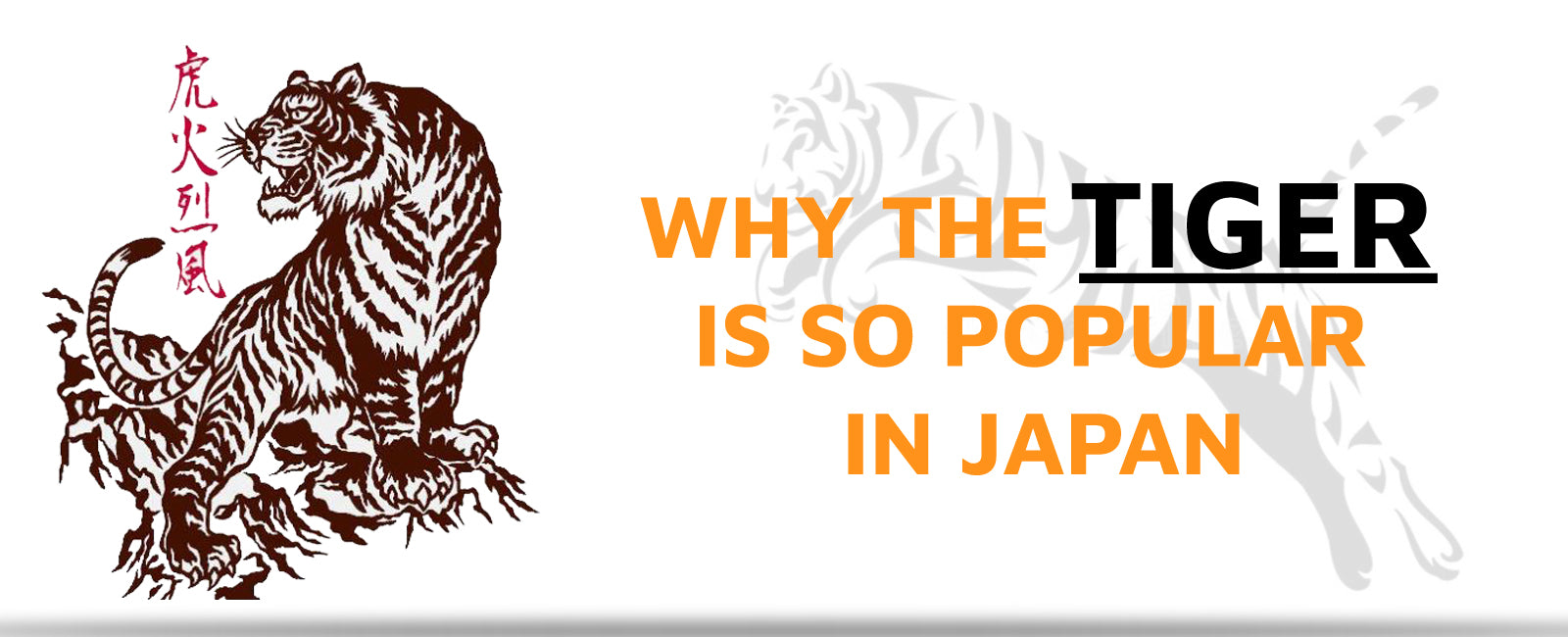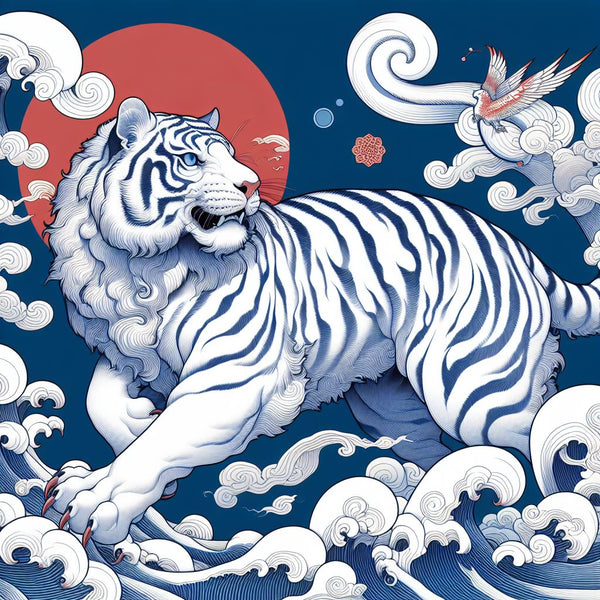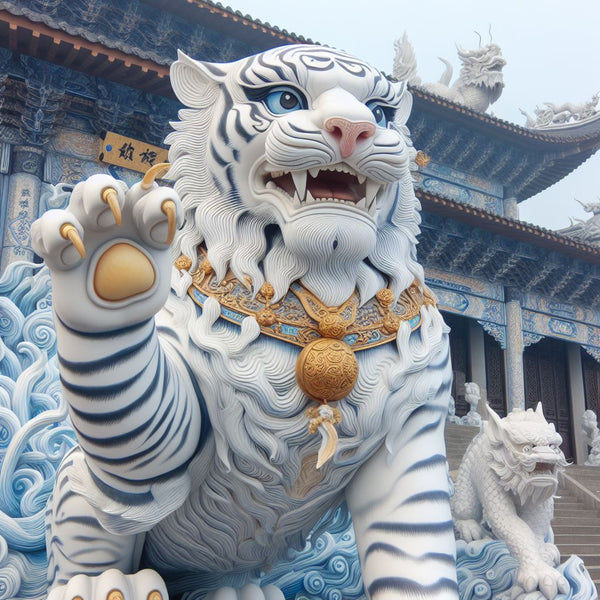Your Cart is Empty
🙏HELP US SAVE TIGERS!🐅 WE DONATE 1% OF OUR SALES TO WILDLIFE ORGANIZATIONS ( WWF ...)
Menu

🙏HELP US SAVE TIGERS!🐅 WE DONATE 1% OF OUR SALES TO WILDLIFE ORGANIZATIONS ( WWF ...)
White Tiger Mythology: A Journey Through Time and Culture
May 28, 2021 11 min read

Have you ever wondered about the majestic white tiger, revered in various cultures across Asia? This article will take you on a fascinating journey through time and culture, exploring the mythology of the white tiger in Chinese, Japanese, and Korean traditions. We'll delve into captivating stories, symbolism, and the enduring legacy of this mythical creature.
The White Tiger in Chinese Mythology

In Chinese mythology, the White Tiger, known as Baihu, is one of the Four Auspicious Beasts, symbolizing power, strength, and courage. Baihu's representation goes beyond a mere animal; it embodies the essence of nature's wrath and serves as a guardian of morality and justice.
Appearance and Powers of the White Tiger
Imagery of the White Tiger brims with awe-inspiring details. Often depicted with blue flames, the White Tiger has the unique ability to transform into a human form. According to ancient tales, this magical shapeshifting ability is a gift bestowed upon it by Huanglong, a divine creature, making the White Tiger an extraordinary being.
Myths and Legends Featuring the White Tiger
The White Tiger plays a significant role in the myths of the Four Symbols and Chinese constellations. These stories highlight the creature's role in the balance of the universe and its connection with the celestial world.

Influence of the White Tiger in Taoism and Feng Shui
In Taoism, the White Tiger is one of the guardians of the Four Directions, representing the west. In Feng Shui, it is associated with the metal element, autumn, and strength. The White Tiger's presence in these spiritual practices emphasizes its connection with power, bravery, and protection.
The White Tiger in Korean Mythology and Culture
Baekho, the White Tiger, holds a prominent place in Korean mythology and culture. Often depicted as a companion to mischievous goblins known as Dokkaebi, Baekho symbolizes power and authority.

Baekho: The White Tiger Guardian and its Cultural Significance
Baekho's cultural significance lies in its association with bravery and protection against evil forces. As a guardian and symbol of power, it remains a vital component of Korean mythology and folklore.
The White Tiger in Modern Contexts
The symbolism of the White Tiger continues to inspire and captivate in modern times. From its role in Feng Shui and Martial Arts philosophy to contemporary Astrology readings, the White Tiger's legacy remains strong and relevant.
From Myth to Pop Culture Icon: The White Tiger's Enduring Legacy
The White Tiger has made its mark in pop culture, including comics, films, and video games. This enduring legacy showcases the creature's timeless appeal and its ability to inspire and entertain across generations.
Embracing the Essence of the White Tiger: Lessons for Personal Growth
The White Tiger embodies universal themes of courage, loyalty, and protection. By understanding and embracing these qualities, we can cultivate personal empowerment, resilience, and a deeper connection to diverse cultural traditions.
In conclusion, the White Tiger Mythology offers a rich tapestry of stories, symbolism, and lessons. By exploring this captivating mythology, we gain valuable insights into the depth and beauty of diverse cultural narratives. So, let your curiosity roam, and immerse yourself in the enchanting world of the White Tiger Mythology.
What Does The Tiger Symbolize in Japan?
Japan is a wonderful country with a diverse range of species. It turns out, however, that the most magnificent of them never developed there! In reality, the Tiger has never been seen in the wild on Japanese soil. Despite the fact that it is not found on these lands, it has a position in Japanese culture. As a result, it is now one of the twelve species of the Japanese zodiac.
Until 1872, when they switched to the Western calendar, Japanese people also celebrated New Year on the same day as Chinese, which usually falls in early February. And just as the Chinese still do, they greeted the New Year at sunset rather than at midnight.
On the other hand, the Japanese zodiac is not entirely identical to the Chinese zodiac. For example, the pig has been replaced by the boar. This is not surprising since the domestic pig was not very familiar to the Japanese, while the boar was common in all households and respected for its courage and strength.
However, it's worth noting that the Japanese did not substitute any other species for the Tiger, which existed in the wilds of Korea and China but never made an appearance in Japan! Many of them are unaware that their most popular species, the tiger, has Chinese origins! Some Japanese aren't even aware that the big cat isn't present on their land.
If the people of Japan are not even aware of the absence of the Tiger in their own country, it is because this subject is still very unknown to the general public. That's why L'Empire du Tigre will give you all the information and anecdotes you need to know about the Japanese Tiger. Even if the beast exists only in the collective imagination, this does not take away the mysterious aura that hovers around it!
The history of the Japanese Tiger
1) What Does The Tiger Symbolize in Japan?

The Tiger has long been recognized in the Japanese archipelago, despite the fact that it has never existed in the wild. It is respected and feared throughout the island as a result of photographs and legends, but mostly as a result of the skins brought in by merchants and soldiers. It's crucial to understand that the Japanese term for tiger, "tora," is derived from the southern Chinese word "taira."
The Tiger first appears in Japanese texts in the year 720, in the Nihon Shoki. It tells the tale of Kashiwade no Omihasui, who was sent to the Korean peninsula's kingdom of Kudara during Emperor Kinmei's 6th year in 545 AD. He took his wife and child with him to represent Japan as an ambassador.When they arrived at the peninsula coast, the sun had set, and in the darkness, the child disappeared, carried away by a tiger. The Japanese ambassador chased the animal and finally killed it with his sword. After that, he returned to Japan with the feline's skin.
The Tiger also appears in the Manyoshu (8th century), Japan's oldest collection of poems, where a poet identifies it as the all-powerful Korean God. This demonstrates intense reverence, admiration, and apprehension for the Tiger. These ideas about the big cat made their way to Japan from the mainland.
The Tiger has thus become a beast to be hated and despised by the Japanese, despite its absence from the Japanese fauna. This animal is featured prominently in many traditional Japanese children's tales. "A feverish roof is more frightening than a Tiger or a Wolf, and reveals that Tigers are only one of many scares!" said one of them, a story that is still told today.
2) The reasons for the popularity of the fawn

The first mention of a live and captive Tiger being brought to Japan dates from the 840s AD, during Emperor Uta's reign. The artist Kose no Kaneoka produced this big fawn. The animal, unfortunately, did not live long and was slaughtered for reasons unknown in ancient writings.
At this time, the medicine based on tiger bones imported from China would have cured the emperor of a severe infection.Every year in November, during the Shinno festival in Osaka, this occurrence is commemorated. Free paper mache tigers are distributed in the hopes of preventing disease. Unfortunately, some people also believe that tiger body parts have medicinal properties. This is fueling poaching and commerce around this endangered species, further threatening the Tiger with total extinction.
During the civil wars in Japan (mid 15th to early 17th century), there was an abundance of Tiger skins imported from China. When the Japanese armies invaded the Korean peninsula in 1592 and all the atrocities committed against the local population, a lot of time and energy was spent on the capture and mass slaughter of Tigers. The general of the armies brought a live Tiger back to Japan to show it to the emperor and other generals.
According to the records, this Tiger was kept in captivity in Osaka Castle and fed with live dogs. The striped fawn needed so many dogs that the villagers supplied them directly to the local chiefs. The Tiger's demise is even more horrific, as it is said to have succumbed to illness after killing one of the puppies. The generals discovered that a villager had poisoned the dog to kill the Tiger when they investigated the incident. Since the Tiger was decimating the pet populations of everyone in Osaka, the villagers decided to defend their dogs.
The story of the Tiger of Osaka Castle and the festival celebrating the medicinal virtues of the feline are 2 of the reasons why the Osaka baseball team is called the Tigers! At the same time, these two events have contributed enormously to the growing popularity of the Tiger in Japan.
3) The reputation of the Japanese Tiger today

Stuffed tigers were often exhibited in public squares during the Edo period (1600-1868). However, as the people became more accustomed to the Tigers' majestic presence. The animal's sense of awe and wonder, which had been synonymous with it for so long, was disappearing. The Tiger had lost its luster in the eyes of the Japanese. However, it continued to represent a symbol of bravery, and statues of Tigers were believed to bring good fortune.
Tiger good luck charms were used to ensure the health and protection of children since tigers were considered to be particularly protective of their cubs. It is also said that the fawn can travel up to 4000km before returning home. This is why it becomes a crucial symbol for soldiers going to war. The Tiger image is also used in Japan to ward off evil and bad energy. At the Kurama temple in Kyoto, Tigers and Lions are in charge of protecting the sacred place!
Today, the Tiger has a reputation far removed from its image several centuries ago. This big cat has become a real boozer in the mind of the Japanese. For them, he is the ultimate protector of the nation, the one who will not give in or back down from anything!
The Tiger in Japanese Art

"Draw what you see," says almost every artist. Many aspiring artists, on the other hand, wanted to take the opposite approach and draw what they couldn't see. This was the case with the illustrious Albrecht Dürer, an early Renaissance draughtsman and brilliant sculptor. A sketch of a massive, extremely realistic Rhinoceros is his most famous work. The artist has created a representation of the African beast and its environment pleated armor with fantastic accuracy, knowing that he had relied solely on stories and testimonials to show Rhinoceros.
Rhinos and tigers are not native to Europe or Japan, respectively. The Siberian forests of Russia, northeast China, and Korea are home to the nearest big cats. However, these colossal carnivores have long been spotted in typical Japanese paintings and silk scrolls.
To represent these terrifying predators, most painters and artists seem to have relied on imported skins. In the mistaken assumption that leopards were female Tigers, many artists drew them. The leopard's spots were peculiar to the Tigress, while the Tiger's stripes were thought to be present only in males.
Closer examination reveals that some artists may have used domestic cats as templates. This would explain why the Tiger has a vertical slit pupil in many old Japanese depictions. Although this trait is not present in the Tiger, it is present in the cat and is easily visible.
Bring the exotic atmosphere of Japan into your home with our Tiger Paintings. ⤵️
To best represent the Great Tiger, the designers were inspired by Taoism, a mystical philosophy derived from the study of nature. In free Taoism, the philosophers saw the universe as a whole balancing between Yin and Yang: the yang, active and masculine, takes the form of a mythological Dragon; the yin, passive and feminine, is associated with the quiet strength of the Tiger. A Buddha statuette can help you find this balance quickly.
Japanese Zen Buddhism shares some beliefs with Chinese Taoism. In Japan, artists have depicted twin dragons and tigers on the doors of Buddhist temples. In this way, for Buddhists, the Tiger has become the companion of wise men. A Tiger grooms himself with the discipline of the monks; his nap is an intense mediation that elevates him spiritually.
The Tiger Legends in Japan
1) Byakko the White Tiger: the oldest Tiger

The Byakko is the Western Celestial Tiger, a mythical creature that resides in the heavens. His name means White Tiger in Japanese, and he bears the character 王 (meaning king) on his forehead, testifying his status as King of the wild beasts. Its appearance is similar to the rare Bengal Tigers with white fur (caused by a lack of pheomelanin in the body).
The Chinese constellation system includes the Byakko. The White Tiger is a celestial being who serves as the protector of a group of star constellations in the western sky. In his insight and purity, he ensures that the natural forces are in harmony.
2) The Origins of the Royal Tiger

An regular Tiger, like the kitsune, a typical fox who transforms into a yokai after 500 years, transforms into a Byakko after 500 years. Once he reaches this age, his tail turns white, and he becomes a yokai, that is to say, a supernatural spirit. As a yokai, he can control the wind and rule over other beasts. However, in Nippon mythology, the Byakko only appears when the ruling emperor is exceptionally virtuous or when the world is at peace.
The Byakko is one of Chinese mysticism's four icons. The four cardinal directions are represented by these four mythological creatures (the Black Tortoise of the North, the White Tiger of the West, the Azure Dragon of the East, the Red Bird of the South, and the White Tiger of the West).
These four mythical animals are also widely represented through Tiger Temporary Tattoos. Like the famous FEMALE TIGER TEMPORARY TATTOO so present in the West nowadays.
The first record of Byakko in Japan is found in the Takamatsuzuka tomb. This circular tomb is located in Asuka's village from between the 7th and 8th century CE. On the walls of this tomb are murals of the four yokai. According to Taoism, the White Tiger, like the other four beasts, also has a human identity. The human name of the White Tiger is Jian Bing.
The White Tiger represents the color white, metal, autumn, and Asian royalty. In the land of the rising sun, he would have the ability and strength to ward off evil spirits. However, its power would be helpful only when figurines are in the heart of the house.
3) The remaining symbols of this White Tiger

Yokai were once depicted to decorate cities, castles, and religious buildings in a traditional Japanese style. The towns had four quadrants, one for each cardinal direction and one for each of the four legendary animals. Even today, you can see traces of their past influences.
For example, in Tokyo, the Toranomon district (which translates as "Tiger Gate") is named after the Byakko. Although the gate facing west no longer exists, its name is still very much present; a statue of this White Tiger also stands a few meters away.
Architect Itō Chūta incorporated these four symbols into the relatively new Heian Shrine design in Kyoto. At the end of the main hall, the western tower is named Byakkorō, or "White Tiger Tower." Statues of the legendary White Tiger inhabit the gardens of the famous shrine. In addition, the lanterns at the eaves of the building are adorned with tiny representations of the four mystical symbols.
To summarize

In the land of sunshine and cherry trees, the striped fawn occupies a place in the esteem of the citizens; that's why the Japanese Tiger is so popular. Artists also love the animal because of its physique and its impressive gait. The meanings surrounding this carnivore vary according to the times. The symbol of punishment and fear in ancient times is now associated with calm and meditative virtue.
Many people do not hesitate to get a tattoo of a tiger or to buy a piece of jewelry with its image so that its serenity flows on them. It is important to note that even if the tiger has never been resident in Japan, it remains fragile. Traditional medicine believes that the tiger is hunted to be used as a remedy for the superstitious.
As a result, some people are willing to pay a high price for even a tiger paw. This conduct is extremely detrimental to the species' stability because it encourages illicit trade and contributes to animal slaughter. As a result, it's important to note that the tiger is a strong wild animal that deserves our respect.
Let's respect it most beautifully, that is to say, without causing it any direct or indirect harm. This is the only way to protect the tiger subspecies from extinction, which has been hovering over them for more than 30 years.
"The protection of the animal is the same fight as the protection of Man. "
Marguerite Yourcenar
Also in Tiger Blog

Sloth Bear vs Tiger: Who Would Win?
July 13, 2024 7 min read
Explore the thrilling showdown between a sloth bear and a tiger, analyzing their strengths, behaviors, and survival tactics.
Read More
Tiger vs Elephant: Who Reigns Supreme in the Animal Kingdom?
July 13, 2024 7 min read
Explore why elephants usually triumph over tigers in the wild, highlighting their size, strength, and defensive prowess.
Read More
Epic Battle: Polar Bear vs Tiger, who win?
July 11, 2024 8 min read
Epic showdown: Polar Bear vs Tiger. Discover who would win in this thrilling battle of nature's fiercest predators.
Read More
